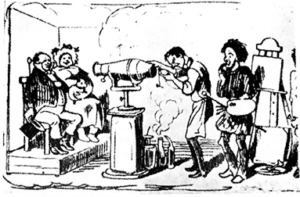Luddites, Lawyers, Illustrators: Embrace AI as a Tool

The Unhappy Painter, by Theodor Hosemann, 1843, illustrating a painter as a victim of technology, made obsolete by photography.
Artificial intelligence (AI) is disruptive and will change the way we create and innovate – similar to disruption from the printing press, the camera, Photoshop, and gene editing. Use of any tool does not remove the need for a human brain and human experience behind the tool’s usage and implementation, and does not inherently preclude IP protection.
Looking at art as one concrete and controversial application, AI is revolutionary, enabling artists and inventors to rapidly create new and unique digital works through platforms such as DALL·E 2. In many ways, AI can be viewed as a new medium for creating art, in addition to paint, pencils, and pixels. Just as artists have always used new tools and techniques to create their work, AI allows artists to explore new forms of creativity and expression. Outside of artistic applications, AI technology is also helping inventors to create new and innovative products- as hot topic technologies of genetic sequencing, 3D printers, and gene editing have enabled in the past.
AI, like any other tool, is only as good as the person using it. A paintbrush, a camera, or a CRISPR enzyme is just an instrument. It is the artist and inventor who puts it to use to create an original innovative work. The user must provide input and direction, and refine and implement the results into a final product.
When the camera was first invented in the early 19th century, it faced resistance and backlash from painters and other artists. The invention of photography was a revolutionary technology changed the way people created and viewed art. Many painters expressed concern because photography could easily and quickly capture a moment or a scene that was difficult to replicate in paint, and some saw photography as a cheap and easy way to produce art that would take away the value of traditional art forms. This is discussed in detail by Aaron Hertzman in his article “Can Computers Create Art?” in which it is noted that “At first, photography, like AI, was seen by many as non-artistic, because it was a mechanical process. Some saw photography as a threat and argued against its legitimacy.”
In addition, Hertzman notes that many artists were dismissive of photography and saw it as a threat to “real art.” Historical accounts indicate that some painters felt that the new technology threatened the financial stability of their profession, and that photographers would take over the market, making it difficult for painters to sell their works. Traditional artists saw photography as a sort of cheating, a tool that created art without the need of skill or training. Sound familiar? We have been here before.
One challenge to widespread adoption of new technologies, including AI, is clarity on how existing works and new creations will be protected and commercialized. Challenges which are already being discussed broadly and in some cases litigated, are IP protection and regulatory requirements related to the use of AI as a tool. There are active copyright protection cases related to usage of artist materials and software as training sets for AI, as well as IP litigation and patent prosecution matters regarding use of AI for innovations such as drug discovery.
The U.S. Patent and Trademark Office is actively engaging with stakeholders in AI and emerging technologies. “The USPTO plays an important role in incentivizing innovation in critical technologies such as AI and other emerging technologies (ET) (e.g., quantum computing, synthetic biology, blockchain, precision medicine, and virtual reality), and maximizing these innovations’ widespread impact to enhance our country’s competitiveness, economic prosperity, and national security, and to solve world problems.” (Kathi Vidal, Under Secretary of Commerce for Intellectual Property and Director of the USPTO). The USPTO is holding a series of stakeholder meetings in order to inform future changes to fulfill this role. (see e.g. https://www.uspto.gov/initiatives/artificial-intelligence for extensive references and upcoming meetings on this topic).
As has happened with previous disruptive technologies, both IP law and regulatory frameworks will need to adjust and case law will clarify the metes and bounds of these systems as they apply to AI.
Technology will continue to advance, and it will be important for policy makers and attorneys to find solutions which protect innovations generated with the assistance of AI tools while respecting existing IP rights. The challenges that AI brings to the table are not entirely new, as similar challenges have been faced with other new technologies including photography, genetic sequencing, and gene editing. But as with any new technology, there will be social license debates regarding adoption, and laws and regulations which will need to be adapted to ensure AI is used responsibly and in a manner that protects the rights of artists and creators.
Cassie J. Edgar, Patent Attorney and Chair of the Regulatory Law practice group, advises clients in intellectual property, regulatory law, crisis management, compliance, stewardship, lobbying, and matters with USDA, FDA, EPA, and FTC. Cassie is also Co-Chair of the Data Privacy and Cybersecurity practice group. For additional information, please visit MVS or contact Cassie directly via email at cassie.edgar@ipmvs.com.
← Return to Filewrapper